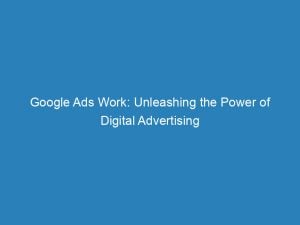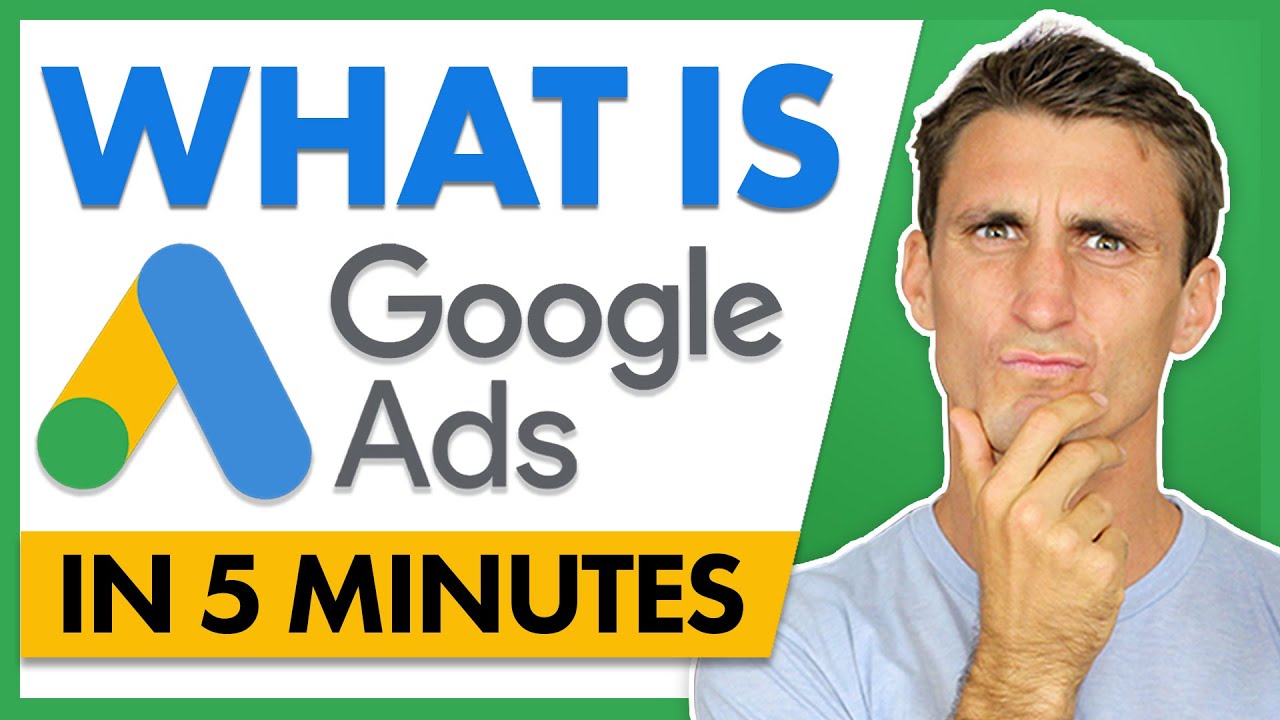In today’s digital landscape, effective marketing is essential for businesses to thrive. With consumers increasingly relying on the internet to search for products and services, companies need a powerful tool to reach their target audience.
Enter Google Ads – a game-changing advertising platform that allows businesses to showcase their offerings to users in real-time. With its ability to display highly targeted advertisements to individuals actively searching for similar products or services, GoogleAds has revolutionized the way businesses connect with potential customers.
But what makes this platform truly indispensable is its pay-per-click model and various bidding options, ensuring companies get the most bang for their buck. In this article, we will delve into the inner workings of Google Ads and explore how it can catapult your business to new heights.
Table of Contents
- google ads work
- 1. Google Ads Display On Search, Maps, And Partner Websites
- 2. Pay-Per-Click Model: Pay For Results
- 3. Different Bidding Options: CPC, CPM, And CPA
- 4. Quality Score Determines Ad Positions And Prices
- 5. Different Types Of Google Ads: Search, Display, Shopping, Video, And App Campaigns
- 6. Wide Reach: 2 Million Websites, 90% Of Internet Users
- 7. Cost Of Google Ads Varies Depending On Factors
- 8. Google Keyword Planner For Choosing Relevant Keywords
googleads work
Yes, Google Ads work. This advertisingplatform effectively showcases advertisements to individuals who are searching for products or services similar to a business.
GoogleAds can be displayed on various platforms including Google Search, Maps, and partner websites. Businesses only pay for results, such as clicks to their website or calls, making it a cost-effective marketing strategy.
Google Ads operates under a pay-per-click (PPC) model, offering different bidding options such as CPC, CPM, and CPA. Ad positions and prices are determined by Quality Score.
With a wide reach, Google Ads can target over 2 million websites and reach 90% of internet users. Successful Google Ads campaigns require a well-defined goal, SMART objectives, targeting the right audience, crafting effective ad copy, tracking and analyzing the campaign using Google Analytics, and optimizing landing pages.
It is also important to avoid using clickbait headlines that can harm brand reputation.
Key Points:
- Google Ads effectively targets individuals searching for relevant products or services
- Ads can be displayed on Google Search, Maps, and partner websites
- Payment is based on results, such as clicks or calls
- Different bidding options and ad positions/prices determined by Quality Score
- Google Ads has a wide reach, targeting over 2 million websites and reaching 90% of internet users
- Success requires setting goals, targeting the right audience, crafting effective ads, tracking and analyzing campaigns, and optimizing landing pages.
- Avoid clickbait headlines.
Sources
https://ads.google.com/home/how-it-works/
https://blog.hootsuite.com/google-ads/
https://www.reliablesoft.net/what-is-google-ads/
https://support.google.com/google-ads/answer/6146252?hl=en
Check this out:
💡 Pro Tips:
1. Use location targeting to reach your desired audience. This will ensure that your ads are shown to people who are most likely to be interested in your products or services based on their location.
2. Monitor your ad performance and make necessary adjustments. Regularly check the metrics provided by Google Ads to see how your ads are performing and make necessary changes to optimize your campaigns.
3. Utilize ad extensions to provide additional information to users. Ad extensions such as call, location, or sitelink extensions can enhance your ads and provide users with more options to engage with your business.
4. Test different ad formats and designs to see what works best. Experiment with different ad formats, designs, and messaging to see what resonates best with your target audience and drives the most conversions.
5. Don’t forget about mobile optimization. With the increasing use of mobile devices, it’s essential to ensure that your ads and landing pages are mobile-friendly to provide a seamless user experience and maximize conversions.
Google Ads Work: Unleashing the Power of Digital Advertising
1. Google Ads Display On Search, Maps, And Partner Websites
Google Ads is an online advertising platform that allows businesses to display ads to people who are searching for products or services similar to what the business offers.
These ads can be displayed on various Google platforms including Google Search, Google Maps, and partner websites. This wide reach ensures that businesses can connect with potential customers at the right moment when they are actively searching for relevant products or services.
2. Pay-Per-Click Model: Pay For Results
Google Ads operates under a pay-per-click (PPC) model, which means that businesses only pay when users click on their ads or make calls directly from the ads.
This ensures that businesses are not spending money on impressions that do not generate any tangible results. By paying for actual results, businesses can track the effectiveness of their ads and make data-driven decisions to optimize their advertising budget.
3. Different Bidding Options: CPC, CPM, And CPA
Google Ads offers different bidding options to cater to the specific goals of businesses.
The most commonly used bidding option is cost-per-click (CPC), where businesses set a maximum bid for each click on their ad. Other bidding options include cost-per-thousand-impressions (CPM), where businesses pay for every thousand impressions of their ad, and cost-per-acquisition (CPA), where businesses pay for specific actions such as a purchase or a lead.
These bidding options allow businesses to choose the most suitable strategy to achieve their advertising goals.
4. Quality Score Determines Ad Positions And Prices
The quality score of an ad plays a crucial role in determining its position and price.
Google calculates the quality score based on factors such as click-through rate, ad relevance, and landing page experience. Ads with higher quality scores are more likely to be shown in top positions and can often achieve better results with lower costs.
It is important for businesses to continuously optimize their ads and landing pages to improve their quality scores and maximize their ad performance.
5. Different Types Of Google Ads: Search, Display, Shopping, Video, And App Campaigns
Google Ads offers a range of different ad formats to cater to the diverse needs of businesses.
These include search ads, which appear on Google Search when users enter relevant search queries, display ads, which appear on websites across the internet, shopping ads, which show product listings alongside search results, video ads, which are displayed on YouTube videos, and app campaigns, which promote mobile apps on various Google platforms. The ability to choose the most appropriate ad format allows businesses to effectively reach their target audience and achieve their advertising objectives.
6. Wide Reach: 2 Million Websites, 90% Of Internet Users
One of the key advantages of Google Ads is its extensive reach.
It can display ads on over 2 million websites and has the potential to reach 90% of internet users. This vast network ensures that businesses can connect with a wide audience and effectively promote their products or services.
The ability to reach such a large number of potential customers increases the chances of generating valuable leads and conversions.
7. Cost Of Google Ads Varies Depending On Factors
The cost of Google Ads is influenced by various factors such as the competitiveness of keywords, the quality of the website, and the bidding strategy chosen by the business.
Highly competitive keywords may require higher bids to achieve prominent ad positions. Additionally, the quality of the website and landing page experience can affect the cost and effectiveness of the ads.
It is important for businesses to carefully manage their advertising budget and optimize their campaigns to achieve the best possible return on investment.
8. Google Keyword Planner For Choosing Relevant Keywords
Choosing the right keywords is integral to the success of a Google Ads campaign.
The Google Keyword Planner tool helps businesses identify relevant and high-performing keywords for their ads. By researching the search volume and competition of different keywords, businesses can strategically select the keywords that are most likely to drive qualified traffic to their website.
Using the Google Keyword Planner can save businesses time and effort in finding the most effective keywords and maximize the impact of their ad campaigns.
In conclusion, Google Ads provides an effective platform for businesses to display targeted advertisements to people searching for relevant products or services. Through a pay-per-click model, businesses only pay for tangible results, ensuring they get the most out of their advertising budget.
With different bidding options, businesses can tailor their strategy to meet their specific goals. The quality score of ads determines their position and price, incentivizing businesses to continuously optimize their campaigns.
With a wide range of ad formats and a vast network, Google Ads has the potential to reach millions of internet users and drive valuable traffic to businesses. By carefully managing costs and utilizing tools like the Google Keyword Planner, businesses can unlock the full potential of Google Ads and unleash the power of digital advertising.












